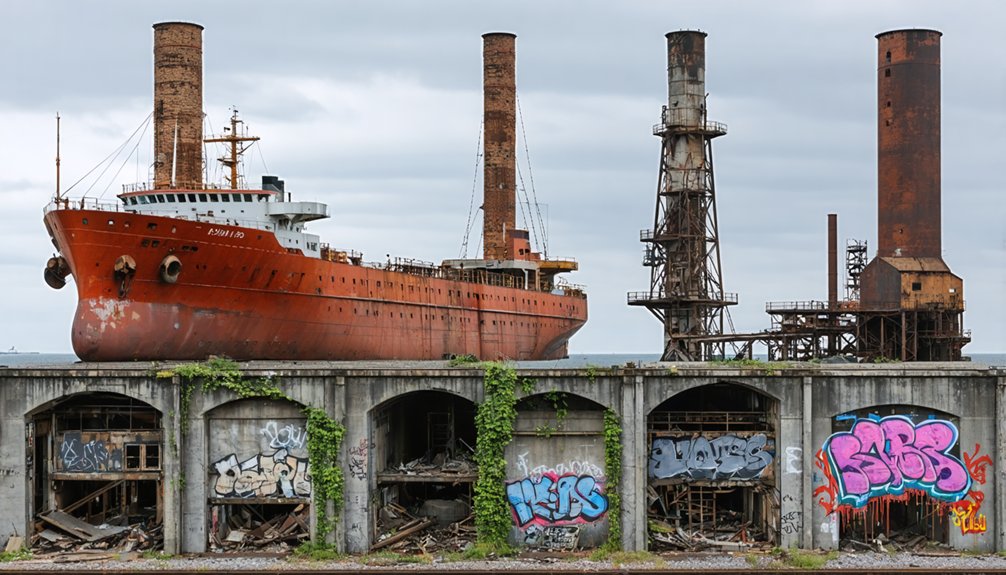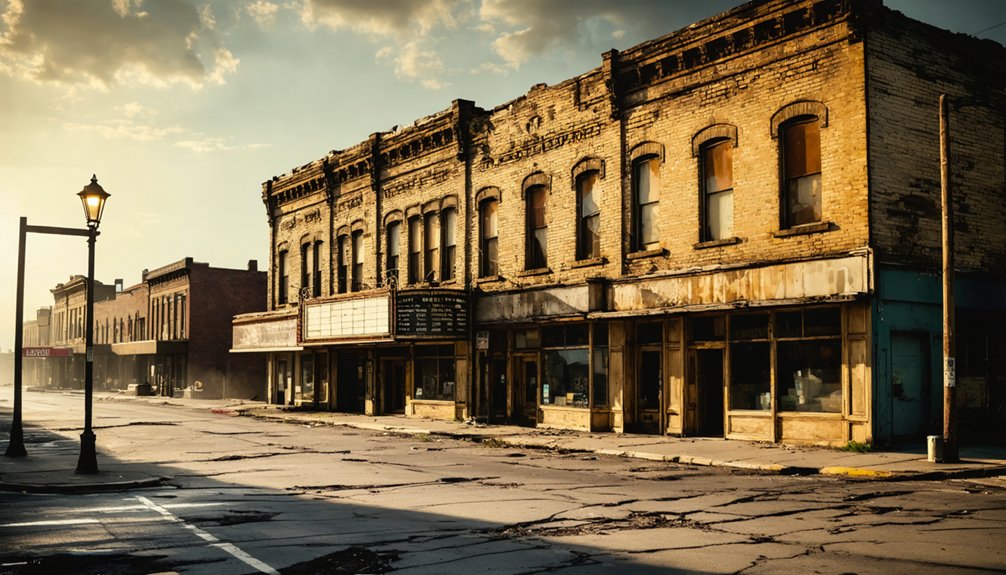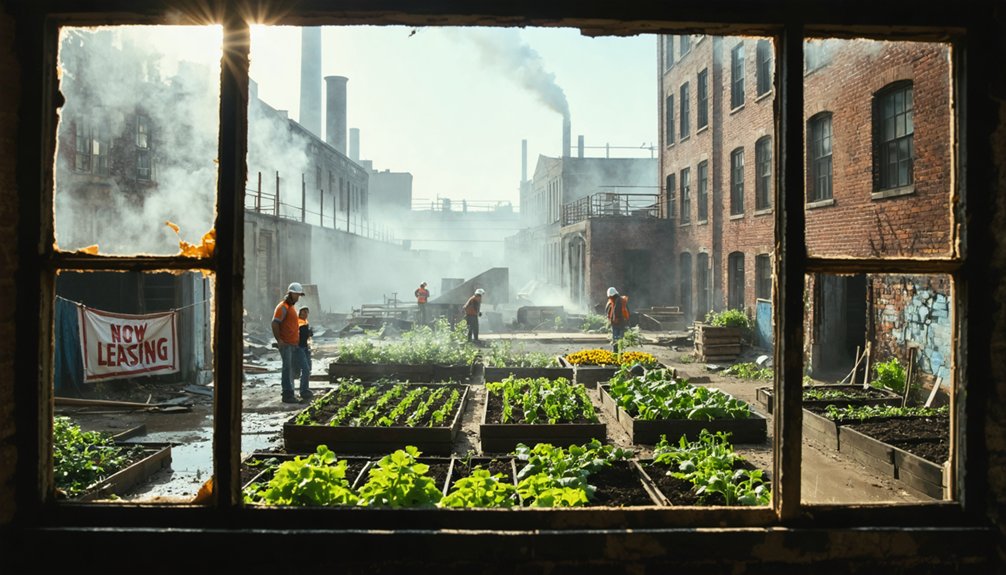You’ll discover the Rust Belt’s most compelling industrial remnants in its massive silent machinery, forgotten company towns, ghost railroads, empty union halls, untouched employee lockers, faded advertising murals, and innovative industrial architecture. These artifacts embody both engineering precision and post-industrial decay, revealing socioeconomic trajectories through their physical forms. Each abandoned structure functions as an unintentional archive, documenting America’s manufacturing prowess and subsequent decline through the built environment’s weathered testimony.
Key Takeaways
- Abandoned factories with massive silent machinery offer dramatic reminders of America’s manufacturing decline and industrial architectural innovation.
- Empty union halls and untouched employee lockers serve as time capsules of worker solidarity and personal artifacts from the industrial era.
- Ghost railroads and abandoned switchyards illustrate the once-vital transportation network that connected manufacturing hubs across the Rust Belt.
- Faded advertising murals and ghost signs on weathered brick facades document regional economic trajectories and commercial histories.
- Forgotten company towns with grid-patterned streets and uniform housing showcase communities once entirely owned by mining and manufacturing corporations.
Massive Silent Machinery: The Beauty of Abandoned Factory Floors
Giants of industry now slumber in the vast expanses of Rust Belt factories, where cavernous spaces stretch across tens of thousands of square meters beneath soaring ceilings.
You’ll encounter massive silent machinery—frozen conveyor systems and dormant presses—that once orchestrated America’s manufacturing dominance.
These nostalgic landscapes reveal a peculiar architectural vernacular: compartmentalized production zones with distinct spatial hierarchies, all designed for maximum output efficiency.
The factory floor’s choreographed layout speaks volumes—each zone a calculated chapter in America’s industrial scripture
Vintage tools and specialized equipment remain in situ, their intricate mechanical forms now draped in rust and decay’s patina.
When you explore these industrial cathedrals, their scale becomes immediately apparent—20-meter clearances accommodate vertical production flows now stilled by economic transformation.
The aesthetic tension between engineering precision and entropic decay creates a compelling narrative of post-industrial America, where freedom from the past remains elusive despite the machinery’s permanent silence.
Many of these abandoned structures exist in historically Black neighborhoods that have experienced the most severe housing and industrial abandonment.
Cities like Dayton and Detroit have experienced dramatic population losses as manufacturing jobs disappeared, leaving behind these industrial relics as memorials to a bygone economic era.
Forgotten Company Towns: Neighborhoods Built Around Vanished Industries
Beyond the hollow factory floors lies another dimension of America’s industrial legacy—the purpose-built company towns that once pulsed with life around now-silent industries.
You’ll find these architectural relics scattered across the Rust Belt—in Iowa’s abandoned coal settlements like Buxton, Kentucky’s timber outposts such as Blue Heron, and Pennsylvania’s steel-centered communities.
Their grid-patterned streets with uniform worker housing, central company stores, and communal facilities reveal the paternalistic framework that both supported and controlled residents’ lives.
When globalization and resource depletion shuttered mines and mills, these communities collapsed, transforming vibrant neighborhoods into monuments to forgotten livelihoods.
The abrupt shift severed deep community bonds, forcing mass migration and fragmentation.
Today, these shells of industrial nostalgia stand as poignant reminders of America’s complex economic evolution—physical representations of both opportunity and dependency. In West Virginia, towns like Coalwood and Gary were entirely owned by mining companies that provided everything from schools to healthcare while extracting the region’s mineral wealth.
These communities experienced a particularly devastating blow during the 1970s industrial decline, when international competition and rising labor costs forced many factories to close their doors permanently.
Ghost Railroads: The Rusted Tracks That Once Connected America’s Industrial Might
Crossing the weathered landscape of America’s industrial heartland, a sprawling network of ghost railroads now stands as the skeletal remains of the nation’s former manufacturing dominance.
These forgotten connections once transported coal, steel, and manufactured goods between thriving industrial centers, their abandonment paralleling the region’s economic descent.
You’ll find these industrial arteries embedded in urban morphology, creating distinctive “scarchitecture” patterns where cities adapted around railway corridors now silent. In Franklin Park, Illinois, former connecting railroad remnants can be seen near two large railyards, marking the area’s industrial past.
- Rusted spurs terminating at vacant factory loading docks
- Crumbling trestles spanning rivers that once carried essential raw materials
- Abandoned switchyards overtaken by succession vegetation
- Repurposed rail beds transformed into recreational corridors
These physical remnants tell a complex socioeconomic narrative—the infrastructure collapse that accompanied deindustrialization, leaving communities disconnected from commercial lifelines that once sustained their prosperity. The decline mirrored the significant manufacturing job losses between 1969 and 1996, when employment in this sector fell by nearly 33% across the Rust Belt region.
Empty Union Halls: Where Labor Movements Once Thrived
Thousands of empty union halls now punctuate the Rust Belt landscape, their cavernous meeting rooms and silent podiums standing as architectural symbols to organized labor’s decline.
These utilitarian brick structures once anchored working-class communities, serving as epicenters of union hall history where collective bargaining transformed industrial wages and conditions.
You’ll find these abandoned facades most prevalent in former manufacturing hubs like Detroit and Pittsburgh, where their deteriorating cornices and faded union insignias tell a story of economic transformation.
The labor movement legacy lives on in architectural details—the large assembly spaces and modest offices designed for worker solidarity.
As you explore these forgotten spaces, you’re witnessing more than vacant buildings—they represent the dissolution of community infrastructure that once empowered workers against corporate interests, before deindustrialization permanently altered the region’s socioeconomic fabric. The decline of these spaces largely coincided with the reduction in union power that began in the late 20th century, fundamentally changing the economic landscape of the region. The dramatic 50% decrease in union membership between the early 1980s and 2015 left these once-vibrant halls increasingly abandoned.
Untouched Employee Lockers: Time Capsules of Industrial Workers’ Lives
Frozen in time since factory doors closed decades ago, untouched employee lockers stand as intimate archaeological sites within abandoned industrial complexes across the Rust Belt.
These vernacular repositories contain worker identity markers and personal artifacts that transcend the architectural remains surrounding them. You’ll find socioeconomic reflections in each compartment—narratives of labor heritage preserved through abrupt closures and economic collapse. In Charleroi, similar remnants evoke the city’s once-thriving coal and steel industry that brought economic power to the region. Cleveland’s abandoned facilities showcase repetitive industrial architecture that characterized manufacturing centers throughout the Midwest during the height of American industrialization.
- Lunchboxes and family photos – humanizing elements revealing workers’ connections beyond factory walls
- Union badges and safety gear – symbols of collective solidarity and workplace hazards
- Handwritten notes and schedules – ephemera documenting daily routines now vanished
- Personal tools and modifications – evidence of skill and adaptation within rigid industrial systems
These industrial nostalgia collections hold archival significance beyond their humble metal casings, offering historians unfiltered access to working-class experiences otherwise erased from official historical narratives.
Faded Advertising Murals: Hand-Painted Industrial Heritage on Brick Walls
You’ll encounter these ghost signs—faded hand-painted advertisements—adorning the weathered brick facades throughout former manufacturing hubs, where they’ve transcended their commercial origins to become architectural palimpsests documenting regional economic trajectories.
These industrial-era murals employed mineral-based pigments and bold typography designed for maximum visibility, techniques that inadvertently preserved fragments of commercial history despite decades of atmospheric pollutants and structural neglect.
As urban revitalization transforms post-industrial landscapes, these advertisements-turned-artifacts occupy a liminal space between commercial ephemera and heritage designation, their weathered presence simultaneously commemorating local manufacturing pride and marking the absence of once-thriving industries.
Ghost Signs Still Stand
Faded whispers of commercial past still cling to weathered brick facades across America’s Rust Belt cities, where ghost signs—those hand-painted advertising murals from the industrial heyday—persist as architectural palimpsests of urban economic history.
You’ll find these weathered advertisements revealing layered narratives of prosperity and decline within the built environment.
Ghost sign preservation efforts combat urban decay while maintaining authentic connections to manufacturing heritage:
- Cleveland’s warehouse district features tobacco and household goods signage, their typography exemplifying mid-century commercial artistry.
- Detroit’s faded Vernors and automotive advertisements mark former commercial corridors.
- Pittsburgh’s steel-adjacent signage creates a material record of industrial supply chains.
- Buffalo’s grain elevator districts host spectacular large-format painted advertisements visible from waterways.
These hand-crafted typographic compositions document shifting consumption patterns while witnessing the region’s economic transformation.
Preserving Bygone Brands
While ghost signs represent the most visible architectural legacy of industrial advertising, their preservation presents complex technical and cultural challenges that intersect with broader urban renewal efforts.
These forgotten brands, painted directly onto porous masonry, face deterioration from moisture infiltration and freeze-thaw cycles that undermine their structural integrity.
Mural restoration initiatives must contend with the scarcity of traditional sign-painting expertise while balancing authenticity against modern conservation technologies.
You’ll find these artifacts serve as essential touchpoints for heritage tourism in adaptive reuse projects, connecting visitors to vanished manufacturing economies.
The visual language of these advertisements transcends mere commerce—they’re sociocultural documents that chronicle working-class narratives and regional identity.
As funding competes with redevelopment priorities, digital documentation platforms have emerged as crucial tools for cataloging these endangered commercial artworks before they disappear entirely.
Artistic Commercial Relics
Ghost signs—those faded advertising murals adorning brick façades throughout the Rust Belt—constitute a distinctive visual archive of America’s industrial zenith.
You’ll find these vernacular artworks concentrated in former commercial districts of Cleveland, Pittsburgh, and Detroit, where limited redevelopment has inadvertently preserved these vestiges of commercial heritage.
- Mural restoration efforts balance authenticity against weathering, preserving patina while preventing structural deterioration.
- Typographic elements reveal evolving commercial aesthetics—from Victorian ornamentalism to streamlined Art Deco.
- Branding nostalgia emerges as communities reconnect with local commercial identities predating mass homogenization.
- Fenestration patterns and building articulation often frame these advertisements, creating architectural dialogue between structure and surface.
These ghost signs represent more than fading pigments—they’re palimpsests of economic change, silent witnesses to bustling streetscapes now quieted by deindustrialization, yet speaking volumes about the region’s once-thriving commercial significance.
Overlooked Industrial Architecture: Design Innovations of America’s Manufacturing Heyday
Beyond the rusting façades and crumbling smokestacks, America’s industrial architecture embodies remarkable design innovations that revolutionized manufacturing spaces during the early 20th century.
You’ll find ingenious daylight design principles in sawtooth roofs that harnessed consistent north light, minimizing glare while maximizing productivity—a passive illumination strategy now experiencing revival in sustainable architecture.
These structures weren’t merely utilitarian; they represented sophisticated environmental engineering.
Massive masonry walls provided substantial thermal mass, naturally regulating interior temperatures without mechanical intervention. Meanwhile, stack effect ventilation systems created natural airflow through strategically placed clerestory windows, moving thousands of cubic feet of air per minute.
When you explore these repurposed industrial spaces today, you’re witnessing not obsolete relics, but forward-thinking designs that anticipated contemporary sustainability principles—pragmatic solutions worth reclaiming from our manufacturing heritage.
Frequently Asked Questions
Are Abandoned Industrial Sites Safe for Urban Explorers to Visit?
No, urban exploration of industrial ruins presents significant hazards. You’ll need extensive safety precautions to navigate deteriorated structural elements, toxic materials, and legal barriers within these post-industrial socioeconomic artifacts.
How Have Former Factory Workers Adapted to Post-Industrial Life?
You’ve pivoted to service sectors through job retraining programs, leveraging community support networks while steering through post-industrial frameworks. Your adaptive resilience often hinges on educational attainment and regional economic diversification.
What Legal Challenges Exist for Redeveloping Contaminated Industrial Properties?
You’ll drown in a tsunami of legal troubles when redeveloping brownfields, facing strict contamination liability under CERCLA, maneuvering through byzantine environmental regulations, and enduring costly site assessments that constrain your adaptive reuse vision.
How Do Rust Belt Communities Preserve Their Industrial Heritage?
You’ll find Rust Belt communities embracing heritage preservation through adaptive reuse of industrial structures, integrating material memory into public spaces, and launching community initiatives that transform manufacturing sites into cultural assets reflecting socioeconomic resilience and architectural authenticity.
What Economic Incentives Exist for Revitalizing Abandoned Industrial Zones?
You’ll find tax incentives through federal BUILD Act credits, state VCTCs covering 75% of remediation costs, public funding via revolving loans, and job creation bonuses that structurally transform post-industrial economic landscapes.
References
- https://www.industryweek.com/talent/article/22028380/the-abandonment-of-small-cities-in-the-rust-belt
- https://themetropole.blog/2017/10/25/on-the-cusp-of-cool-the-problematic-nature-of-rust-belt-narratives-in-two-new-histories-on-cleveland/
- https://www.britannica.com/place/Rust-Belt
- https://www.indire.net/Articles/V8P041-071Tamiggi579.pdf
- https://rustbeltrecruiting.com/a-history-of-the-rust-belt-and-why-its-important/
- https://research.upjohn.org/cgi/viewcontent.cgi?params=/context/up_press/article/1242/&path_info=up14wbrttr_2.pdf
- https://www.youtube.com/watch?v=orM7mOwy11k
- https://backend.production.deepblue-documents.lib.umich.edu/server/api/core/bitstreams/e73fb3cd-4f75-4e88-b3b4-dcb2ecec2713/content
- https://allthatsinteresting.com/rust-belt
- https://en.wikipedia.org/?title=Rust_belt



